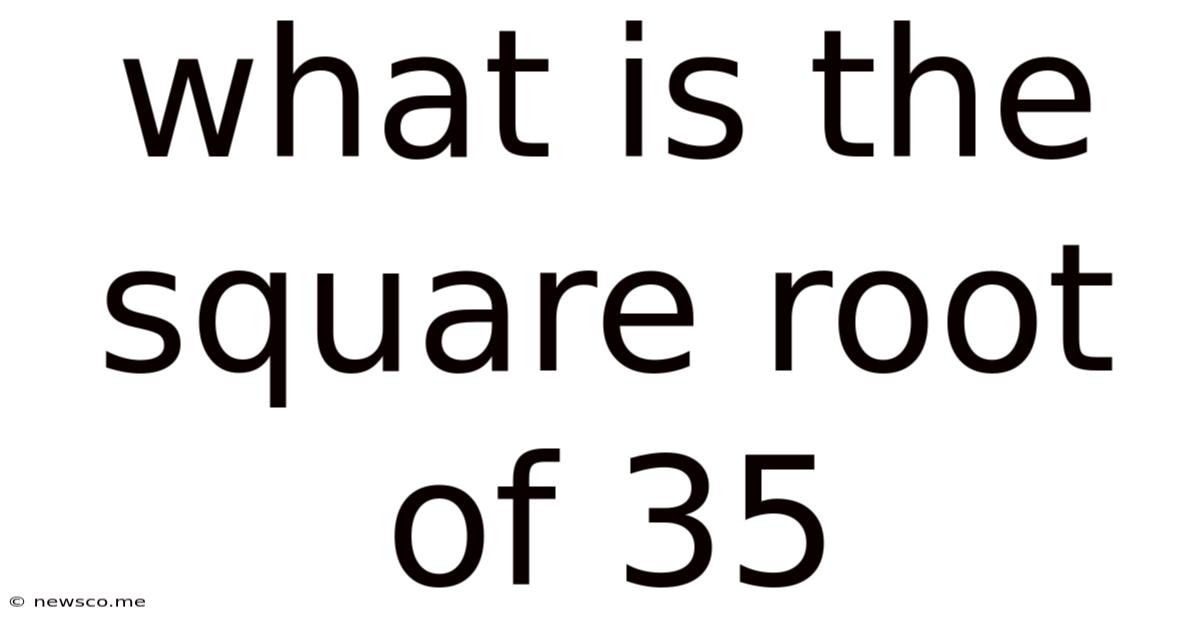What Is The Square Root Of 35
News Co
Mar 24, 2025 · 4 min read

Table of Contents
What is the Square Root of 35? A Deep Dive into Square Roots and Approximation Techniques
The question, "What is the square root of 35?" seems simple enough. However, exploring this seemingly straightforward mathematical problem opens a door to a fascinating world of number theory, approximation methods, and the very nature of irrational numbers. This article will delve deep into understanding the square root of 35, examining its properties, exploring various methods for approximating its value, and discussing its significance in mathematics and beyond.
Understanding Square Roots
Before we tackle the specific case of the square root of 35, let's establish a firm understanding of what a square root actually is. The square root of a number, denoted as √x, is a value that, when multiplied by itself (squared), equals the original number, x. In simpler terms:
√x * √x = x
For example:
- √9 = 3 because 3 * 3 = 9
- √16 = 4 because 4 * 4 = 16
- √25 = 5 because 5 * 5 = 25
However, not all numbers have perfect square roots – meaning whole numbers as a result. This is where the square root of 35 comes into play. 35 is not a perfect square; there is no whole number that, when multiplied by itself, equals 35. This means the square root of 35 is an irrational number.
Irrational Numbers: An Infinite Decimal
Irrational numbers are numbers that cannot be expressed as a simple fraction (a ratio of two integers). Their decimal representation goes on forever without repeating. This is a key characteristic of the square root of 35. It's not a neat, easily expressible number; it's a never-ending string of digits after the decimal point.
√35 ≈ 5.916079783... (The "..." indicates that the digits continue infinitely).
This infinite nature poses a challenge: we can never write down the exact value of √35. Instead, we rely on approximations to work with it in practical applications.
Methods for Approximating √35
Several methods can help us approximate the square root of 35 to a desired level of accuracy. Let's explore a few:
1. The Babylonian Method (or Heron's Method)
This iterative method refines an initial guess to get closer and closer to the actual value. The formula is:
x_(n+1) = 0.5 * (x_n + (a / x_n))
Where:
- x_n is the current approximation
- x_(n+1) is the next, improved approximation
- a is the number whose square root we're seeking (in this case, 35)
Let's start with an initial guess of x_0 = 6 (since 6*6 = 36, which is close to 35):
- x_1 = 0.5 * (6 + (35 / 6)) ≈ 5.9167
- x_2 = 0.5 * (5.9167 + (35 / 5.9167)) ≈ 5.91607978
- And so on...
Each iteration brings us closer to the actual value. The Babylonian method is relatively simple to understand and implement, even by hand.
2. Using a Calculator or Computer
The easiest and most common method is to simply use a calculator or computer software. Most calculators have a square root function (√) that provides a highly accurate approximation.
3. Linear Approximation
A simpler, though less precise, approach is linear approximation. We can use the fact that √36 = 6. Since 35 is close to 36, we can approximate:
√35 ≈ 6 - (1/12) ≈ 5.9167 (where 1/12 is a rough estimate of the change in the square root function near x = 36)
4. Newton-Raphson Method
This is a more advanced iterative method for finding successively better approximations to the roots of a real-valued function. It's based on the tangent line approximation and offers faster convergence compared to the Babylonian method.
Significance of √35 in Mathematics and Beyond
While √35 might seem like a relatively obscure number, its significance extends beyond simple mathematical exercises. Irrational numbers like √35 are fundamental to various fields:
-
Geometry: The square root often appears in geometrical calculations, such as finding the diagonal of a rectangle or the hypotenuse of a right-angled triangle using the Pythagorean theorem.
-
Trigonometry: Trigonometric functions often involve irrational numbers in their values.
-
Physics: Many physical phenomena are described by equations involving square roots, including calculations related to velocity, acceleration, and energy.
-
Computer Graphics: Square roots are crucial in algorithms used for rendering 3D graphics and animations.
-
Engineering: Various engineering applications, such as structural calculations and circuit design, involve computations that necessitate dealing with irrational numbers.
Conclusion: The Enduring Mystery of √35
The seemingly simple question of "What is the square root of 35?" leads us to a richer understanding of mathematics. The fact that √35 is an irrational number highlights the complexity and beauty of the number system. While we cannot express its exact value, we have various techniques to approximate it to any desired degree of accuracy, from simple methods like linear interpolation to more sophisticated iterative algorithms such as the Babylonian or Newton-Raphson method. The significance of this and other irrational numbers extends far beyond theoretical mathematics, impacting numerous practical applications in science, engineering, and technology. Ultimately, the exploration of √35 provides a valuable insight into the fascinating and ever-expanding world of numbers.
Latest Posts
Related Post
Thank you for visiting our website which covers about What Is The Square Root Of 35 . We hope the information provided has been useful to you. Feel free to contact us if you have any questions or need further assistance. See you next time and don't miss to bookmark.